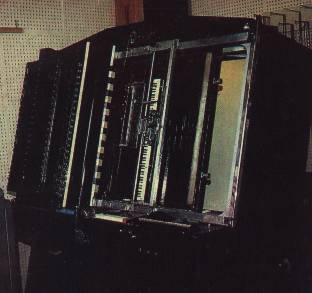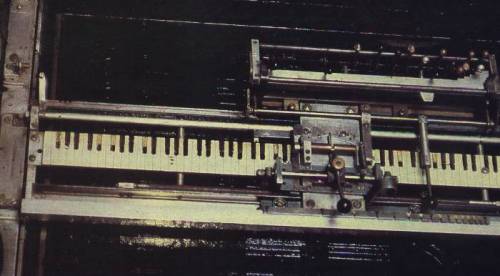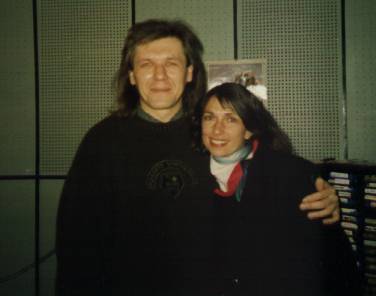THE ELECTRONIC MUSIC
IN EASTER EUROPE
Chapter 1
By: Jorge Munnshe
It is impossible to attempt to compress the musical universe
enclosed behind the iron curtain by decades in a single mini-series. A basic approach to
the reality of the musical avantgardein each one of the multiple, rich cultures of this
great unknown which is Eastern Europe, nowadays in full development, would need the making
of a book. Therefore, this mini-series will only be a brief vision, perforce incomplete,
of these innovative styles sustained on cultures maybe as ancient or even more so than
those in the rest of Europe.
 It is difficult to make an updated portrait of the situation in the Eastern
countries, due to the spectacular, fast changes that are taking place in them. For
instance, the track of numerous musicians living in the former Yugoslavia has been lost,
after they changed from sharing the same nationality to becoming citizens of confronted
warring communities. After the end of the war, contact with several of them has been
re-established. Yet there are some whose present status is currently unknown and whose
personal circumstances previous to the beginning of the war seem to suggest a personal
tragedy. In this sense, I will be grateful for any information forwarded to me on the
current situation of alternative musicians from the ex-Yugoslavia. Emailme at:
It is difficult to make an updated portrait of the situation in the Eastern
countries, due to the spectacular, fast changes that are taking place in them. For
instance, the track of numerous musicians living in the former Yugoslavia has been lost,
after they changed from sharing the same nationality to becoming citizens of confronted
warring communities. After the end of the war, contact with several of them has been
re-established. Yet there are some whose present status is currently unknown and whose
personal circumstances previous to the beginning of the war seem to suggest a personal
tragedy. In this sense, I will be grateful for any information forwarded to me on the
current situation of alternative musicians from the ex-Yugoslavia. Emailme at:
THE STATES OF THE EX-USSR
Immediately after the founding of the USSR, the attitude of the Party towards the artistic
manifestations diverging from the pre-established canons to explore other terrains was
quite favourable. The reason for this is the fact that they were considered a form of
Communist Revolution within the arts, as they demolished the aesthetics shaped during
centuries of aristocratic and bourgeois domination. Therefore, the kind of music
completely divergent from the Classical style, then identified with the old society to be
changed, received the benediction of the authorities, and its production was promoted.
Nevertheless, this situation was not to last for long. After the
first few beats of the new regime, idealism gave way to the techniques of repression.
Alternative art became a synonym for defiance to The Establishment, in this case the
socialist state, and later a palpable sign of subversion. The artists of new trends were
also revealed as potential agitators, if not having openly hostile attitudes towards the
dictatorship. In these circumstances, it was better to promote artistic orthodoxy, well
known and therefore easily controlled, rather than risking strange ideas that could
contain philosophies contrary to the regime and whose mere manifestation was in a way a
rebellious act or one of dangerous individuality. Once this musical revolution had been
smothered, its initiators were prosecuted because of their political attitude, or had to
convert to more orthodox musical forms due to the boycott suffered by their more risky
works. Among these pioneers mention must be made of Nikolai Roslavetz
(1881-1944), Sergei Protopopov (1893-1954) and Alexander Mossolov
(1899-1973).
The interest in electronic music in the states of the ex-USSR, is
not new, either. And not only the interest, but also the active research in this field.
Russian composer Lev Termen developed
pseudo-synthesizers in the 1920s, with which he toured Europe and America harvesting an
enormous success through concerts of electronic music. It had been always thought that the
great economic depression suffered by the United States, the country where he had settled,
made him desist from carrying out his projects, and that it was for this reason that he
came back to Russia. However, recently another version of the story has been revealed,
according to which Termen was kidnapped in the United States by Soviet
secret agents and was taken back to the USSR. His scientific genius would have
whetted the Supreme Sovietappetite for brains.
 Volodin is another
forgotten pioneer.
Volodin is another
forgotten pioneer.
In the 1930s, professor Sholpo established a
laboratory for sound synthesis where he developed his variophone, a precursor of the
synthesizers.
In the early 1960s, and while Moog was designing
his own synthesizers in America, Eugene Murzin developed his ANS
synthesizer independently, whose first prototype already functioned in 1961, the
year in which the Russian forefather of electronic music, Edward Artemiev,
used it in his compositions. Also in these early days, the Skriabin Studio for Electronic
Music was created in Moscow. Similarly, mention must be made of Sophia
Gubaydullina, Edison Denisov, Alfred Schnittke, Oleg Buloshkin, Stanislav Kreichi, and
Yuri Bognadov because of their historical work, among other composers related to
the research in sound as well as the New Music and Electroacoustic genres.
Nonetheless, despite these worthy developments, technology in the
USSR did not advance beyond the analogic. Foreing digital instruments were only available
to those artists tutored by the government, most of whom were devoted to the most
commercial trends of Pop music, with the least content or message, and certainly without
critical attitudes against The Party. The main problem that "amateur" musicians
in these countries had was the lack of adequate musical technology, which had to be bought
in the black market ten times more expensively than its cost in the Western countries. In
some countries computer technology was forbidden even if it was a present brought among
the luggage of a foreigner. In the Soviet states, the only popularly available computer
was the Commodore-64. Likewise, one must take into account that the copyrights for the
release of an album granted the musician were so scarce, that the main source of income
had to be their live performances.
 Sergey Tutov and
Oleg Onoprienko are musicians who collaborate with Edward Artemiev.
On April 1990, they began to produce the radio programme Tangerine Wave, on the (at those
times) State Radio Television of the USSR. They had scarce means to carry out their
projects. Due to these always surprising peculiarities of the Soviet Kafkaesque
bureaucracy, they only had an available CD-player. They did not limit themselves to
playing electronic or avantgarde music, but also they spoke about it, the musical
technology involved, and the new artistic concepts. The audience success was remarkable,
as the new musics were subversive there, almost as much as Rock was. Pop and Classical
music were, on the contrary, supported by The Party.
Sergey Tutov and
Oleg Onoprienko are musicians who collaborate with Edward Artemiev.
On April 1990, they began to produce the radio programme Tangerine Wave, on the (at those
times) State Radio Television of the USSR. They had scarce means to carry out their
projects. Due to these always surprising peculiarities of the Soviet Kafkaesque
bureaucracy, they only had an available CD-player. They did not limit themselves to
playing electronic or avantgarde music, but also they spoke about it, the musical
technology involved, and the new artistic concepts. The audience success was remarkable,
as the new musics were subversive there, almost as much as Rock was. Pop and Classical
music were, on the contrary, supported by The Party.
In the USSR functioned the Association of Electroacoustic &
Computerized Music, under the auspices of the Composers Union. This state association
carried out very scarce activities, and its concerts were "parodies", according
to what several musicians claim. The members of the Association were allowed to enter
competitions and festivals abroad. However, they could not do so in their own country, as
there were none.
Perestroyka allowed for the founding of some private record labels
devoted to the new musics in Russia, a fan club of electronic music, and other entities
and collectives. Likewise, the programme Tangerine Wave was joined by others, both on the
radio and the television. The first TV programme devoted to this kind of musics was
produced by the Ukrainian Television. In Ukraine there is so much interest in the new
musics as there is in Russia; for instance, a festival on New Music has been held in Kiev
for quite some time, and the Ukrainian Radio sponsors the release of electronic music
albums.
Gorizont became known as some sort of Russian
version of Kraftwerk, releasing an LP by the "Soviet State"
record label Melodia, which after the Perestroyka came to release things that were
unthinkable a few years before.
Another release by Melodia was the band Jungle, a
combination of Jazz with ethnic musics, relying on synthesizers.
Valentina Ponomareva was described in her debut as
a fusion of Enya and Diamanda Galas.
 Igor Cherniakski, who
was a member of a Polish Rock band, is now devoted to the new musics as a soloist.
Igor Cherniakski, who
was a member of a Polish Rock band, is now devoted to the new musics as a soloist.
Sven Grumberg is the global composer of
synthesizers, fusioning styles and instruments from Europe, India, China and Tibet in an
electronic texture highly sophisticated in nature.
Several new avatgarde artists appear in a compilation album promoted
by the LAVA association. Another sampler, this one with "official" support (as
well as fourteen thousand copies, together with international distribution) gathers
experimental pieces performed by veteran artists recorded in the late 1960s and the early
1970s, with the ANS synthesizer. In it we can find: Sophia Gubaydullina, Alfred
Schnittke, Edison Denisov, and of course, Edward Artemiev. Other
important native samplers are the ones by the Russian label Electroshock Records, as well
as the ones produced by Western labels, among which most remarkable are the ones released
by Erdenklang.
At the same time, in Russia and Ukraine, many synthesists are
appearing, although most of them are devoted to Techno or Trance music. Some of the most
remarkable ones are EDS, Oleg Makeyev and Zartipo.
For more information about the available releases by those artists
and sound clips, use these links:
Edison Denisov
Sophia Gubaydullina
Alfred Schnittke
BOOK: "Alfred
Schnittke (20Th-Century Composers)" by Alexander Ivashkin
 Previous Page (Articles/News)
Previous Page (Articles/News)
 It is difficult to make an updated portrait of the situation in the Eastern
countries, due to the spectacular, fast changes that are taking place in them. For
instance, the track of numerous musicians living in the former Yugoslavia has been lost,
after they changed from sharing the same nationality to becoming citizens of confronted
warring communities. After the end of the war, contact with several of them has been
re-established. Yet there are some whose present status is currently unknown and whose
personal circumstances previous to the beginning of the war seem to suggest a personal
tragedy. In this sense, I will be grateful for any information forwarded to me on the
current situation of alternative musicians from the ex-Yugoslavia. Emailme at:
It is difficult to make an updated portrait of the situation in the Eastern
countries, due to the spectacular, fast changes that are taking place in them. For
instance, the track of numerous musicians living in the former Yugoslavia has been lost,
after they changed from sharing the same nationality to becoming citizens of confronted
warring communities. After the end of the war, contact with several of them has been
re-established. Yet there are some whose present status is currently unknown and whose
personal circumstances previous to the beginning of the war seem to suggest a personal
tragedy. In this sense, I will be grateful for any information forwarded to me on the
current situation of alternative musicians from the ex-Yugoslavia. Emailme at: Volodin is another
forgotten pioneer.
Volodin is another
forgotten pioneer. Sergey Tutov and
Oleg Onoprienko are musicians who collaborate with Edward Artemiev.
On April 1990, they began to produce the radio programme Tangerine Wave, on the (at those
times) State Radio Television of the USSR. They had scarce means to carry out their
projects. Due to these always surprising peculiarities of the Soviet Kafkaesque
bureaucracy, they only had an available CD-player. They did not limit themselves to
playing electronic or avantgarde music, but also they spoke about it, the musical
technology involved, and the new artistic concepts. The audience success was remarkable,
as the new musics were subversive there, almost as much as Rock was. Pop and Classical
music were, on the contrary, supported by The Party.
Sergey Tutov and
Oleg Onoprienko are musicians who collaborate with Edward Artemiev.
On April 1990, they began to produce the radio programme Tangerine Wave, on the (at those
times) State Radio Television of the USSR. They had scarce means to carry out their
projects. Due to these always surprising peculiarities of the Soviet Kafkaesque
bureaucracy, they only had an available CD-player. They did not limit themselves to
playing electronic or avantgarde music, but also they spoke about it, the musical
technology involved, and the new artistic concepts. The audience success was remarkable,
as the new musics were subversive there, almost as much as Rock was. Pop and Classical
music were, on the contrary, supported by The Party. Igor Cherniakski, who
was a member of a Polish Rock band, is now devoted to the new musics as a soloist.
Igor Cherniakski, who
was a member of a Polish Rock band, is now devoted to the new musics as a soloist.